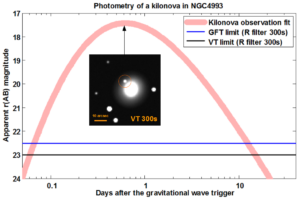Variable and transient bodies have played a major role in astronomy for a long time, as shown by the observations of Chinese astronomers reported 4000 years ago (see the article). Comets, novae, variable stars, supernovae, gamma bursts or coalescence of compact objects causing the emission of gravitational waves are among the objects of this variable and transient sky, far from the classical representation of an unchangeable, static sky.
The rise and the interest in observing the transient sky are closely linked to the technological developments and progress of detection tools: more sensitive sensors, therefore shorter exposure times, access to new wavelength domains, increased power of storage and data processing resources, the advent of wide-field cameras mounted on increasingly large telescopes, their effectiveness and interaction with alerts given by the instruments developed in the field of non-magnetic messengers.
Variable and transient sky objects
The difference between a variable object and a transient object can be defined in part by the unpredictable nature of the phenomenon and from the observational point of view on the detection limit of the instrument, a variable object remaining detectable at any time while a transient source falls below the detection limit. In both cases, the time scales of variation can be different. Another aspect that highlights the difference between the two categories is the impact of variability on the very nature of the object. A source can be variable not by an intrinsic change in its composition but by an external effect such as the transit of a planet in front of a star that modifies the brightness of the target star for the observer. In the case of a transient source, the change of state is followed by a profound physical transformation of the system causing in some cases (gamma bursts or supernova) the death of the host star. The study of the transient sky thus makes it possible to better understand phenomena such as the processes of matter accretion in binary systems, ejections in the form of jets in gamma-ray bursts, the behaviour of a plasma in the presence of intense magnetic and gravitational fields or the coalescence of two compact stars. Transient objects can belong to the Milky Way or be located at much greater distances such as active galaxy nuclei. They are observed today in different wavelengths.
The video above illustrates the highly variable nature of the sky when observed at certain wavelengths. The sequence results from the continuous observation of the sky (represented here in galactic coordinates) by the ASM instrument of the RXTE space mission in the X-ray domain (between 5 and 12 keV) during the period 1996-1999, i.e. 4 years of data. Sources appear suddenly or suddenly change in brightness. They are mainly distributed along the galactic plane (figure at the bottom) and for the most remarkable their name is shown. Credit: http://xte.mit.edu/.
The transient sky and the SVOM mission: strategy and observation program
While the main goal of the SVOM mission is to ensure the observation of about 100 gamma-ray bursts per year, it is also a formidable tool for probing the transient sky. To observe phenomena occurring on short time scales (sometimes less than a second), significant detection and monitoring devices are required. Like its sister mission SWIFT, developed by NASA, the SVOM mission leaves an important place in its observation program for the non-GRB science. SVOM will be able to generate an alert after the detection of a transient phenomenon, thanks in particular to its large field of view instruments Eclairs and GRM. Conversely, the mission will be able to react to alerts (targets of opportunity, ToO) from other transient sky observatories, on the ground or in space, and then point its instruments towards the object. SVOM will thus be a partner of choice for other observation programs, in particular those dedicated to the study of the transient sky, such as the LSST project in the visible domain or by the SKA network in radio frequencies.
Multi-messenger astronomy
The mission will also be able to respond quickly to alerts from the IceCube or KM3N neutrino telescopes or from the LIGO and Virgo gravitational wave interferometers.
The initial goal of the mission, the study of gamma-ray bursts, will thus be extended to the study of gravitational waves. Predicted since Einstein and the theory of general relativity, these oscillations of the curvature of space-time became reality after the announcement on February 11, 2016 of their discovery by the LIGO/Virgo collaboration, crowning years of research and technological development. The signal detected on September 14, 2015 by the two interferometers of the LIGO project is interpreted as the signature of the very last moments of the fusion of two black holes of thirty solar masses each. This same network of interferometers detected another event on August 17, 2017, this time accompanied by a short gamma emission received by ESA’s Integral and NASA’s Fermi high-energy satellites. Here, the phenomenon observed both in the form of gravitational and electromagnetic waves corresponds to the fusion of two neutron stars, a hypothesis long advanced to explain short gamma-ray bursts.
These major discoveries confirm the coalescence scenario of two compact objects (neutron star and/or black hole) as a source of gravitational wave emission and open up new horizons for example their use as a potential cosmological probe.
Neutrino astronomy is another multi-messenger field where the SVOM mission can make a significant contribution by seeking in this case the electromagnetic counterpart of the neutrino signal, the first step towards source identification.
The challenges of the time domain
The study of the transient sky is a rapidly developing branch of astronomy and many observatories currently under development and dedicated to this topic will be set up by 2020. In this context, the scientific community faces many challenges. The main challenge is to process data in real time in order to detect transient phenomena as quickly as possible and to broadcast alerts effectively. The large amount of data and the number of people involved also require a specific organisation to ensure the effective diffusion and follow-up of alerts, a task and challenge that the project’s scientists are actively preparing.
A quarter of SVOM’s observation time will be dedicated to the detection of gamma-ray bursts, while 15% in the first two years and 40% in the third year will be devoted to transient phenomena (excluding bursts).





